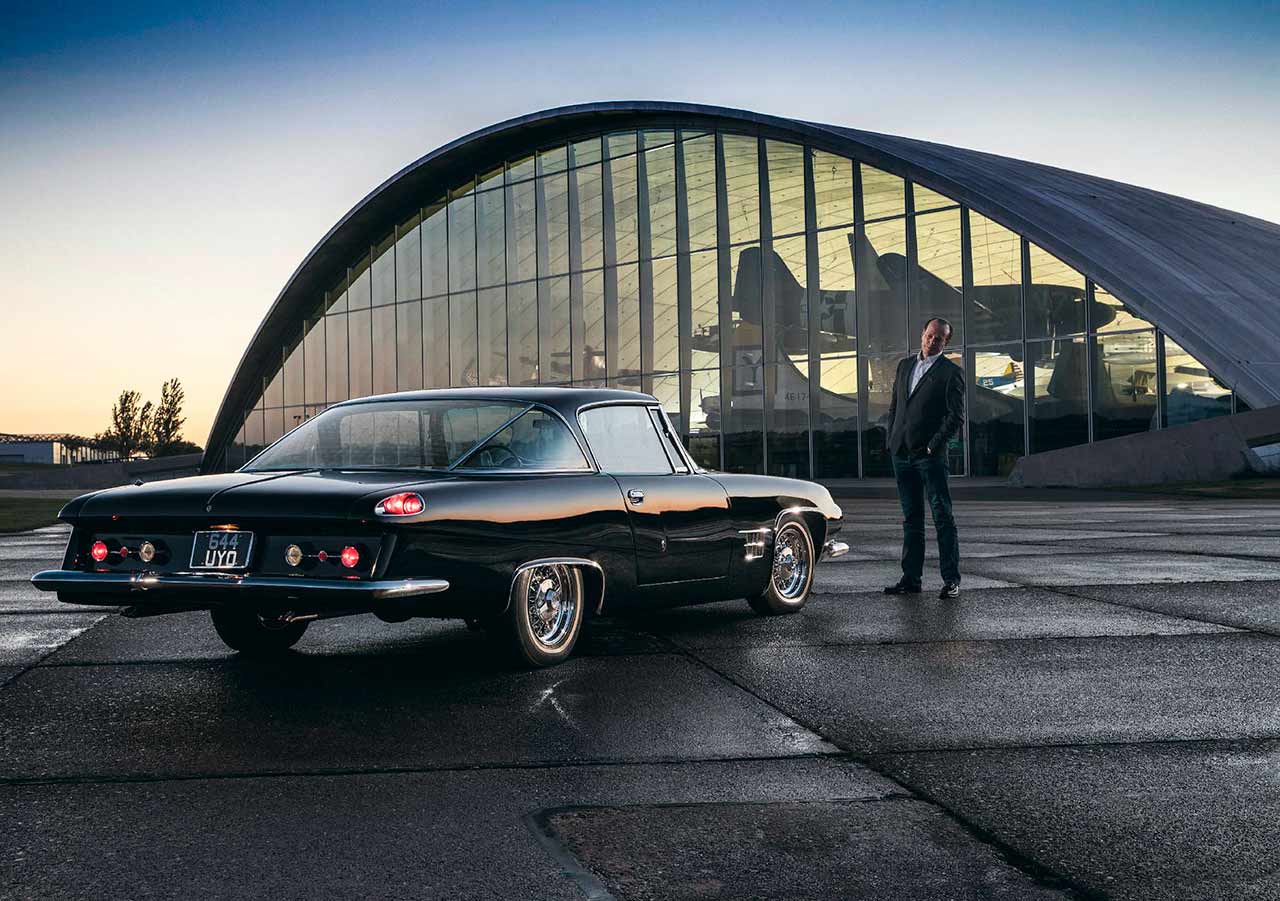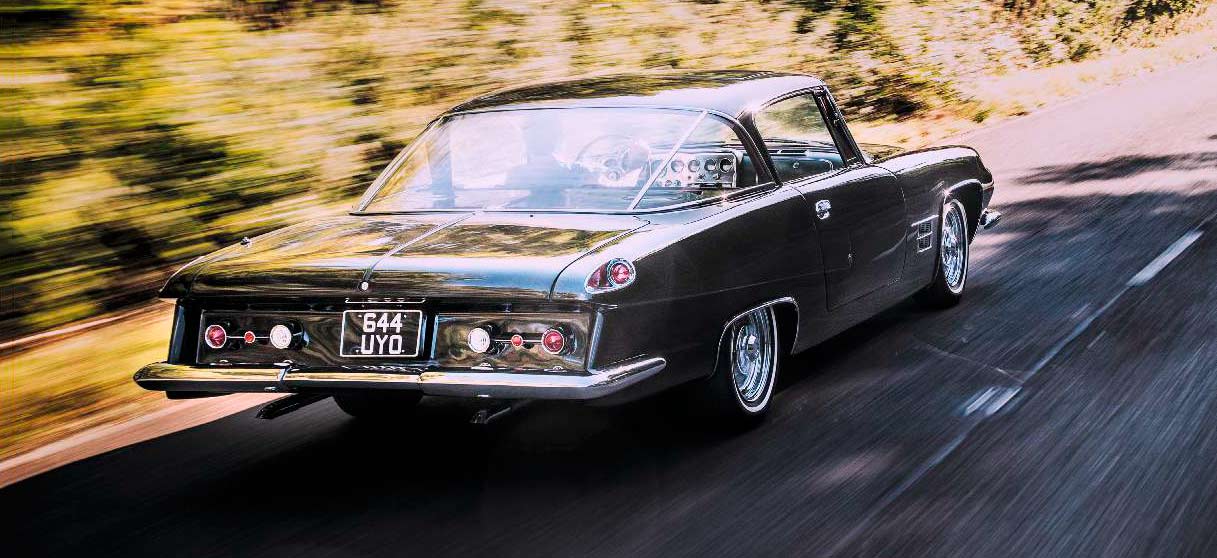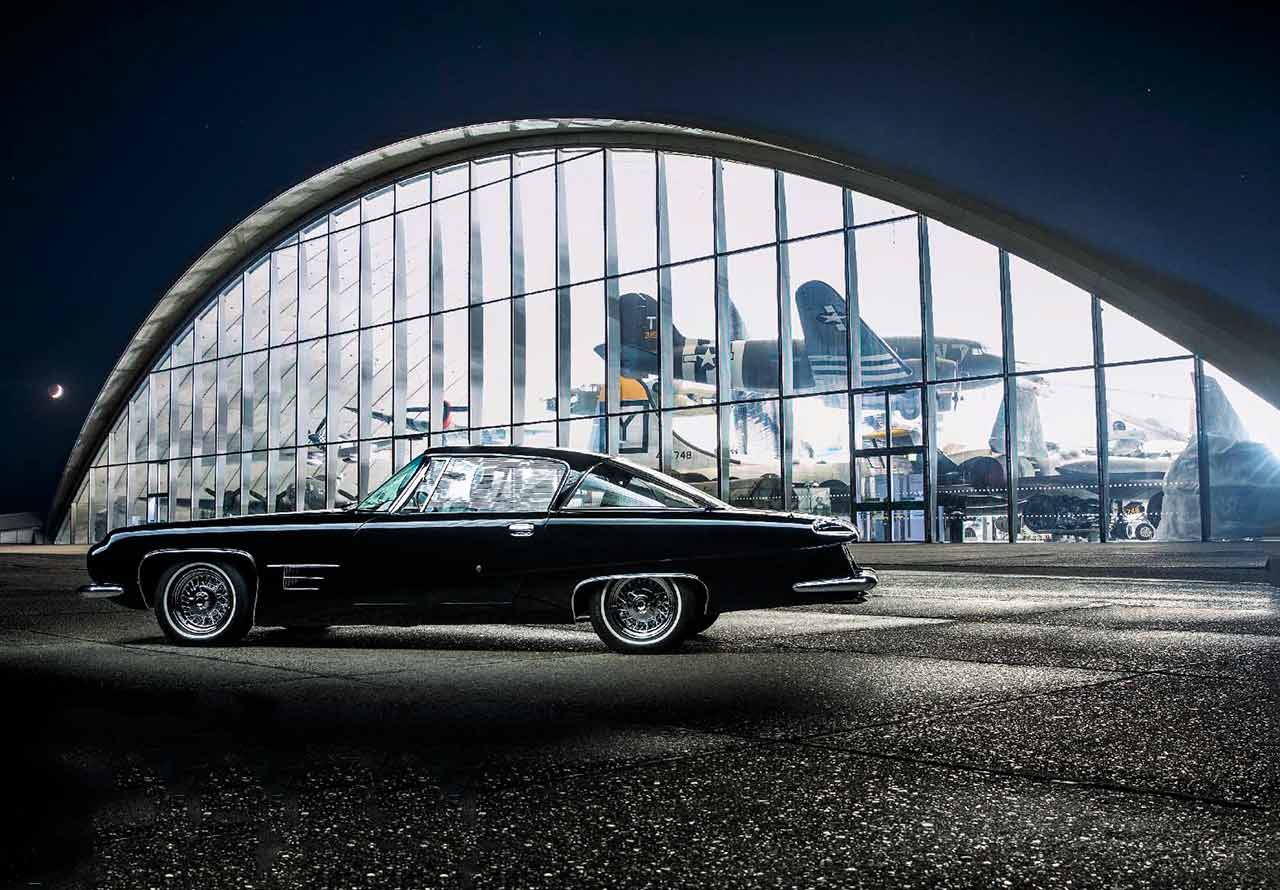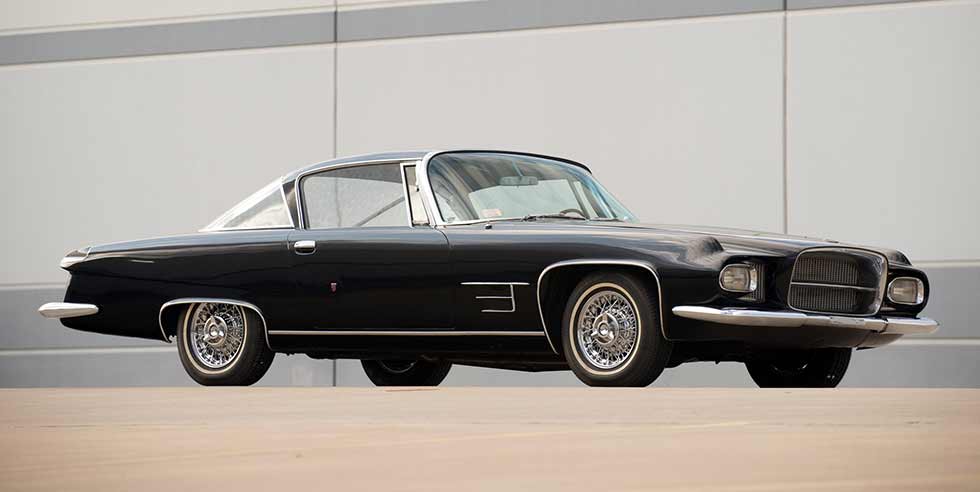
Gary Cooper’s Ghia L6.4. Quentin tries the jet-set life. Driven Ghia L6.4 Quentin’s dazzled by the Ghia’s dashboard – and star-struck by its provenance. Top Ghia Ordered new by a Hollywood star who died before he got to drive it, this Ghia L6.4 is one of 17 examples of a car that the Rat Pack turned into a jet-age status symbol. Now it’s Quentin Willson’s turn to take the controls. The Ghia L6.4 was once the preserve of Hollywood’s high-fliers. Now it’s Quentin’s turn to take the controls of this jet-age rarity. Words Quentin Willson. Photos Charlie Magee.
Blowing most of your pension on a Sixties Italian-American crossbreed that nobody’s heard of might not sound like a terribly good idea, but for one far-sighted enthusiast such a reckless act has turned into a total triumph. In less than two years the value of his unconventionally reinvested pension has grown by nearly 100%. This is a story of gut instinct overriding caution with spectacular results. Our hero is a man whose investment theology is simple – classic cars made in minuscule numbers with a special history rarely go down in value. A nugget of advice that should make us all pause for thought.

1962 Ghia L6.4 road test
Graham (he’d prefer if I didn’t share his surname) has a collection of low-volume, special-body Fifties Cadillacs and a Facel Vega Excellence. But top of his collector’s dream list had always been one very special car – the mythic Ghia L6.4. Only 26 were ever made and only 17 survive, making it rarer than a Ferrari 250 GTO. A futuristically beautiful Mopar-muscle Italianate GT, it became the transport icon of the Hollywood and Las Vegas Rat Pack with roots stretching all the way back to Harley Earl and the GM Motorama experimental cars that thrilled so many millions of Americans in the Fifties.
And our story begins with one of those Motorama cars – Chrysler’s 1954 Fire Arrow IV roadster penned by Head of Advanced Design, Virgil Exner. Despite rave reactions from the 1.9 million visitors at the 1954 Motorama, Chrysler decided not to put the Fire Arrow into production. But Eugene Casaroll of the Dual Motors Corp (he invented the eight-vehicle car transporter) had a commercial relationship with Chrysler shipping its new cars to dealers. This inner-circle position allowed him to buy the rights to the Fire Arrow along with a supply of Dodge underpinnings. By 1955 Casaroll had struck a deal with Ghia in Italy to design, build, paint and trim a new body. The shells were then shipped back to the US for electrics and final assembly. In 1957 Casaroll launched the Dual-Ghia convertible at $7646 and crossed his fingers.
Even though it cost $200 more than a Cadillac Eldorado Biarritz Convertible, it didn’t take long for the Dual-Ghia Convertible to become the hottest ride on the street – 1957 America was obsessed with space-age cars and movie stars. Frank Sinatra, Ronald Reagan, Peter Lawford, Desi Arnaz and Lyndon Johnson owned them, and when Dean Martin drove his in Kiss Me Stupid the Dual- Ghia was America’s most lavish and expensive car. But that was part of the problem. Weighing in at 3600lb (1633kg) the 230bhp Dual-Ghia wasn’t exactly light on its feet. Throw in Casaroll’s obsession with quality (each car took 1500 hours to build) plus a very limited market, and the numbers just didn’t stack up. Only 117 Dual-Ghias were made between 1956 and 1958 at which point Casaroll’s failing health saw him ask Dual-Ghia’s Vice President, Paul Farago, to step in and create a completely new model.
Enter the Ghia L6.4, launched at the 1960 Paris Motor Show. Low, sleek, conservatively styled with no baroque Fifties finnery, the L6.4 used crate Dodge 388ci V8s and Chrysler’s Torqueflite auto with a high-end cabin, bespoke instruments, a Nardi woodrim wheel, a polished metal dash and a deep centre console. If there was ever a design grammar for Las Vegas slot machines you’ll find it in the L6.4’s cockpit. Buttons and switches have that overwrought Sixties alloy look – each a statement of flamboyant excess in its own right. That form over function was the L6.4’s raison d’être is proved by the spindly chrome transmission selector, which had no Park function. You optimistically held your $13,500 L6.4 on hills with the flimsy foot-operated handbrake. And yes, it really did cost $13,500 – or nearly double the price of a contemporary Cadillac. But owning an L6.4 wasn’t just about money, it was all about status. Sinatra had the first car (now in the National Automobile Museum in Reno) followed by Lucille Ball, Debbie Reynolds, Glenn Ford, Peter Lawford and, after much pleading, Dean Martin. The L6.4 became so exclusive that Hollywood gossip columnist Dorothy Kilgallen said, ‘A Rolls-Royce is the Hollywood status symbol for those who can’t get a Ghia.’ Sinatra and Martin even had their cars subtly improved by LA custom king George Barris, who modified six of the 26 L6.4s made. Graham’s car (chassis 0308) is one of those special six, originally ordered by film star Gary Cooper and registered in 1962.

1962 Ghia L6.4 road test
By that time ‘Coop’ had died, and the L6.4 spent a reclusive early life in Beverly Hills until it popped up in an LA dealership in 1971 for $5500. Local car accessory company owner Bill Van Gove traded in his 1958 Dual-Ghia convertible along with $3000 and kept 0308 for 23 years. Gove kept a ping-pong bat in the glove box with ‘1962 Ghia L6.4’ written on it to hold up on the freeway for curious onlookers. In 1994 he passed 0308 to his son-in-law, who had it restored. In 2015, after 45 years in the same family ownership, 0308 was sold by RM in Monterey for $297k to our man Graham. I’ll let him take up the story.
‘I’d always wanted a Ghia and thought it would be the perfect addition to my collection. I spent years watching the prices rise. I missed the Dean Martin car at $117k and then saw the same car sold again later for $199k. So when one of the six Barris-modified cars came up at RM I had to go for it. American car experts Dream Cars in London helped me buy the car by telephone – I didn’t even see it before bidding. I timed it well, though. Back then the dollar was £1.54 to the pound – not like now.’ Graham had his Ghia shipped back to the UK, and over the past 16 months has been scooping up prizes at local events. And during that time, the wisdom of that buying impulse has been proved conclusively.
‘My wife and I were at a car show and this guy kept walking round the car – he must have come back to it eight times. Then he handed me his chequebook and told me to write a cheque for whatever I wanted. And he definitely wasn’t joking.’ Graham didn’t sell, because his instinct told him that such unprecedented admiration means his Ghia is indeed enormously desirable and likely to stay that way – a view vindicated in August this year when another Ghia went under RM’s hammer in Monterey. Chassis 0319 had been beautifully restored but had no celebrity ownership and wasn’t one of the six Barris-customised Ghias, yet made $577,500. Which means that in 16 months Graham’s pension has potentially increased in value by $260k. And he now owns something rather more captivating than a spreadsheet full of numbers.
The Ghia L6.4 drives much better than you’d think. It’s slung deceptively low and you have to watch your head climbing in. For several minutes you’re distracted by the twinkling dash and fiddle with all the jukebox switches. Twist the key and there’s an immediate Mopar V8 rumble from the twin exhausts and the Ghia gently rocks on its engine mountings as you blip the gas. Snick the selector into D and it takes off smartly with a turbine-like whoosh.
Then comes the big surprise – the ride. No clonking or shuddering, just serene flat progress that reminds you of a Silver Shadow. The Ghia’s body control feels taut, modern and well damped, and the clever front torsion bar system and semi-elliptical rear springs do their job with aplomb. The assisted steering has plenty of play but feels direct and positive on turn-in. Lean into a roundabout and the Ghia won’t lurch or wallow but stays level and planted. The 6.3-litre Carter-fed 335bhp V8 feels brisk enough to suggest the claimed 8.5-second sixty time and 140mph top end might be achievable but the interior is so quiet and well-insulated you don’t want to try – and in deference to Graham’s pension I don’t.
But the overwhelming sensation is of hand-engineered poise. The Ghia only feels like a lump of Sixties Americana when the V8 soundtrack intrudes. The rest of the time it drives like a very upmarket XJ6 – silent, plush, smooth-riding and lively – with a strange space-age sensation from those huge windows and all that light. But the real magic happens when you get out and close the door.
You don’t just look at the angles, planes and surfaces, you drink them in. The lines are otherworldly, from a time when Americans thought they’d soon be living on the moon and transported there by personal rocket ships that looked a lot like the Ghia. Around the same time Sinatra released his smash hit, Fly Me to the Moon, with a Lockheed Constellation on the record sleeve. This was space travel re-imagined for the road.
That such a tiny car company could build America’s most glamorous Sixties car and make its A-listers queue up to own one is remarkable. But the Ghia L6.4’s real significance comes from its Motorama DNA. The work that Earl and Exner did at GM’s studios in the Fifties really was a zenith of car design. The Ghia L6.4 is one of those experimental cars that escaped its turntable and headed for Hollywood. The Rat Pack made that sensational shape a badge of rank.
Maybe they sensed that their fabulously expensive Ghias were the final flourish of pure, impulsive, visionary car design? Those 17 surviving L6.4s precisely capture a moment in America’s past before JFK was assassinated and almost everything seemed possible. Graham didn’t just invest in a classic car – he bought a unique and exquisite page from America’s social and cultural history. Clever man.
TECH
‘The Ghia L6.4 is one of those experimental cars that escaped its turntable and headed for Hollywood’
‘He drove with the car’s name on a ping-pong bat for curious onlookers’
‘Rarer than a 250 GTO, with low, sleek styling and no baroque Fifties finnery’
TECHNICAL DATA FILE 1962 Ghia L6.4
Engine 383ci (6276cc) Chrysler ‘Wedge’ V8, ohv, Carter four-barrel carburettor
Gearbox Three-speed TorqueFlite automatic
Power and torque 335bhp @ 4600rpm; 410lb ft @ 2400rpm / SAE
Steering Recirculating ball, power assisted
Suspension Front: independent torsion bar and telescopic dampers, anti-roll bar. Rear: live axle with semi-elliptical leaf springs and telescopic dampers
Brakes Hydraulic drums front and rear
Performance Top speed: 140mph; 0-60mph: 8.5sec
Length 5330mm (209.8in)
Width 1910mm (75.2in)
Weight 1860kg (4100lb)
Fuel consumption 12mpg
Cost new $13,500 (£4818 in 1962)
Values now £300,000-£400,000

Customiser George Barris swapped round factory headlights for new rectangular Cibies and concealed indicators behind the front grille. Quentin is physically and figuratively dazzled by the chrome dashboard.

Low-slung rear deck punctuated by additional afterburner-style tail lights. Interior had everything a Sixties Hollywood crooner could wish for, including a centre-console loudspeaker.

Squared-off wheelarches were a design cue inherited from the Dual-Ghia then amplified. Film star Gary Cooper fell for the Ghia’s sharp, suave lines and ordered this particular car – but died before it could be registered.
THE GHIA L6.4 MARKET
For years nobody wanted Ghia L6.4s. US collectors saw them as overstuffed Dodges and preferred to pay the big money for rare muscle cars. In 1999 Kruse sold 0320 for $60k and then in 2002 it knocked down 0311 for just $50k.
In 2009 RM struggled to get more than $117k for the Dean Martin car. Peter Lawford’s car 0302 – the second built and directly connected to Sinatra who had the first – was sold on eBay in 2010 for $100k. In the same year 0320 went back on the market with RM and sold at Amelia Island for $126,500.

1962 Ghia L6.4 Coupe
This is when auction watchers saw the Ghia’s potential, noting a $60k rise in the 11 years between 0320’s two auction appearances.
In 2012 Hyman Classic Cars of St Louis put the Dean Martin car on eBay at $199k and the press picked up the story; suddenly the Ghia L6.4 got its celebrity mojo back. Prices then really started to move. Hyman advertised 0313 for $379k and in 2015 RM created a new record, selling 0309 for $412k at its Arizona sale. Graham’s car – 0308 – was a relative bargain given the growing market interest and $297k for one of the six Barris cars now looks good value indeed.
The current highest price for an L6.4 is $577k sold by RM in Monterey in August 2016. Prices are likely to carry on rising and the Barris cars or those with Hollywood or Rat Pack connections will always command a hefty premium. And if 0301 – Sinatra’s car – ever comes to market, expect to write a cheque for upwards of $1m.
THE RAT PACK
The influence of the Rat Pack in America in the early Sixties was huge. Frank Sinatra, Dean Martin, Sammy Davis Jnr, Peter Lawford and Joey Bishop were the undisputed kings of cool, filling the whole of Las Vegas with adoring admirers. Sinatra had more Top 50 albums than Elvis Presley. The gang worked together on films like Ocean’s Eleven and when one was performing on stage at The Sands, the others would turn up unannounced to join in.

Ghia L6.4 Rat Pack
Stories of their high life captivated America. Sinatra gave away $50,000-worth of solid gold cigarette lighters before he was 30. They even had enough influence to help JFK (Peter Lawford’s brother-in-law) get elected by publically supporting him.
And they loved their cars. Sinatra had a Dual-Ghia Convertible, one of the first Thunderbird roadsters, a Continental MkII and a 1958 Cadillac Eldorado Brougham.
Martin had a Facel Vega HK500 and Davis Jnr a Rolls Silver Cloud convertible. Sinatra’s, Lawford’s and Martin’s patronage of the Ghia L6.4 gave it such a cachet of exclusivity that in 1961 Motor Trend included in their road test the prophetic lines: ‘Since there are likely to be more persons with the price than there are Ghia L6.4s there will surely be other qualifications for purchase than mere money. The new Ghia may well be a prestige car that picks its own buyers on their prestige.’
Those words directly referenced the Rat Pack – America’s coolest customers.





